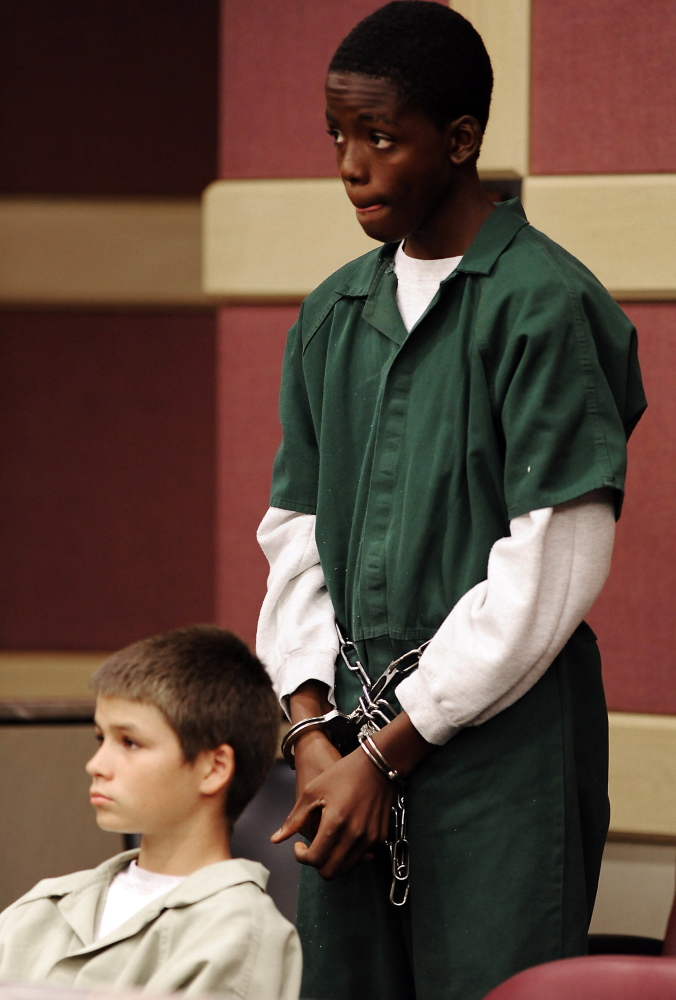Lost in the rancor that marked the end of the legislative session was a modest bill that would have protected the safety of children and the dignity of our courtrooms.
L.D. 1029, “An Act to Improve Maine’s Juvenile Justice System,” would have, among other things, established a presumption against the shackling of youth in juvenile court, while retaining a judge’s discretion to impose restraints if the youth poses a safety or flight risk.
The bill received strong bipartisan support in the Joint Standing Committee on Criminal Justice and Public Safety and was approved by large majorities in both the House and the Senate, but was subsequently vetoed by the governor. And, unfortunately, when the vote to override the veto came up in the House, several representatives switched their prior vote to sustain the governor’s veto.
As a result, Maine continues to have no written, publicly accessible statewide policy on the shackling of juveniles in court. But it should, and here’s why:
Shackling undermines the rehabilitative purpose of the juvenile justice system. Most of the youth who appear in juvenile court are charged with misdemeanor or non-violent felony offenses. The vast majority pose no threat to themselves or the public and are not a flight risk.
Unnecessary use of shackles alters the tone of a juvenile proceeding from rehabilitative to primarily punitive and degrading, which can inhibit a young person’s ability to engage in the process.
Indeed, the U.S. Supreme Court has held that shackling adults violates the presumption of innocence and creates unfair bias in the courtroom. So most adults are not shackled in court proceedings.
Experts in child and adolescent psychiatry confirm that for a youth, shackling in the courtroom can create a sense of shame and embarrassment, and may have significant impact on their self-image. The humiliation young people experience may harm identity development in ways that are more damaging and lasting for adolescents than for adults.
We also know firsthand that these emotional impacts affect some youths’ ability to communicate effectively with counsel.
All of this is important from a public safety perspective. Research shows that youth are far less likely to re-offend when the juvenile justice system treats them fairly. Court appearances can be traumatizing even without the shackles. Studies show that merely appearing in court increases the odds a student will drop out of high school.
In short, shackling adolescents to “teach them a lesson” may be very damaging and more likely to result in further delinquent behavior, rather than less.
Shackling is an artifact from the days when kids were thought of as a younger version of adult criminals; we now know that is not true, and we’ve designed a dramatically different approach to addressing juvenile delinquency with, overall, much better results.
Earlier this year, the American Bar Association passed a resolution urging all federal, state, local and territorial and tribal governments to adopt a presumption against the use of restraints on juveniles in court.
Notable national child health and welfare organizations like the Child Welfare League of America, the American Academy of Child and Adolescent Psychiatry and the National Center for Mental Health and Juvenile Justice oppose indiscriminate shackling of youth. So does the Association of Prosecuting Attorneys.
The time is past due for Maine to have a clear policy on this issue. Currently, 21 states have some written policy limiting the use of shackles; most other states are considering legislation or are engaged in other types of rule-making process.
In New England, Maine and Rhode Island are the only two states that do not have a publicly accessible policy on the shackling of juveniles.
For a policy to work well, it needs to be clear to all those involved to ensure it is properly implemented and that all stakeholders are held accountable. In juvenile court, everyone from judges to law enforcement to defense attorneys to prosecutors to the young person and their family have a stake in what goes on in the courtroom and should know the rules.
While the practice of unnecessarily shackling juveniles in court is not widespread across the state, the failure to articulate a uniform public policy leaves young people unnecessarily vulnerable.
L.D. 1029 did not survive the politics of the legislative session, but all is not lost. The Judicial Branch has the power to enact a rule that makes it clear that kids in Maine will not be indiscriminately shackled in court. We encourage them to take that opportunity and finish what the Legislature started.
Send questions/comments to the editors.



Success. Please wait for the page to reload. If the page does not reload within 5 seconds, please refresh the page.
Enter your email and password to access comments.
Hi, to comment on stories you must . This profile is in addition to your subscription and website login.
Already have a commenting profile? .
Invalid username/password.
Please check your email to confirm and complete your registration.
Only subscribers are eligible to post comments. Please subscribe or login first for digital access. Here’s why.
Use the form below to reset your password. When you've submitted your account email, we will send an email with a reset code.